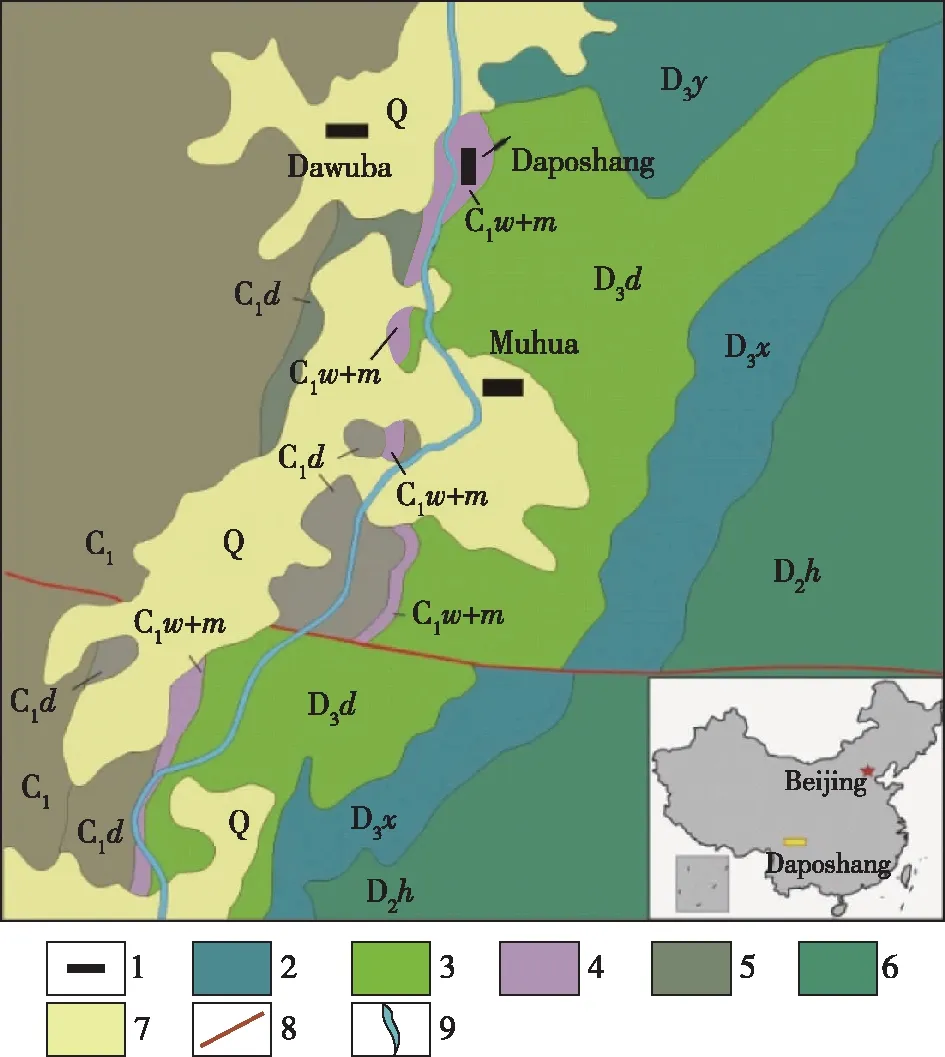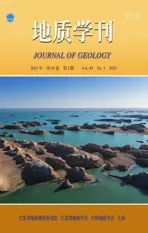On the dating ages of the Devonian-Carboniferous boundary in Southern China
2021-04-28季燕南,梁蕾,季强
Abstract: This paper makes an introduction to the dating ages of the Devonian-Carboniferous boundary in South China, based on the Nanbiancun section in Guangxi and the Daposhang section of Guizhou. The Nanbiancun section of Guangxi falls into the slope, gravity-flow sedimentary facies, and the conodont sequence is somewhat chaotic. Although the D-C boundary was fixed between ′Bed 56′ and ′Bed 57′, the so-called ′bed′ numbers are actually the conodont sampling numbers. ′Bed 55′ to ′Bed 58′ are a single shell-limestone, from which 4 conodont samples were collected. The paper believes that it is unacceptable and unscientific in theory to place the D-C boundary within the shell-limestone. It is unreasonable to separate the brachiopod individuals into 2 parts, that is to place the lower part in the Upper Devonian, and the Upper part in the Lower Carboniferous. The samples used for dating were taken from ′Bed 58′ and ′Bed 66′, which are clearly higher than the occurrence position of Siphonodella sulcata (conodonts) in the profile. It is clear that the D-C boundary age of (361.0±4.1) Ma obtained by them is neither credible nor desirable. The Daposhang section in Guizhou falls into the sedimentary facies of deep-water basin, and it is the only section in China yields both the Wocklumeria Fauna and the Gattendorfia Fauna. Liu et al. (2012) collected a tuff sample for dating from the D-C event bed of 2-4 black shale at the basal part of the Wangyou Formation and obtained a zircon U-Pb concordant age of (359.6±1.9) Ma. This age is close to, but older than the D-C boundary age of (358.9±0.4) Ma given by International Commission on Stratigraphy (2020). Superficially, this age seems credible and acceptable, but its error is huge, and the data is not precise enough to make the final word now. It is necessary to collect again samples from the Daposhang section in order to verify the accuracy of the age. Personally, it is acceptable that the age of the D-C boundary is about (358.9±0.4) Ma, and that the age of the D-C event bed ranges from 360.0 to 361.0 Ma.
Key words: the Daposhang section; the Nanbiancun section; the age of the D-C boundary; Southern China
0 Introduction
The Muhua area is quite famous for the well-developed strata of deep-water facies and aboundant fossil groups, such as conodonts and ammonites, of Late Famennian and Early Tournaisian (Hou et al., 1985; Ji et al., 1989). In the Muhua area, the Upper Devonian is composed of the Xiangshuidong Formation (below) and the Daihua Formation (above), and the Lower Carboniferous consists of the Wangyou Formation (below), the Muhua Formation (middle) and the Dawuba Formation (above) (Fig. 1). The Daihua Formation with theWocklumeriafauna in this area is equivalent with theWocklumeriaLimestone in Western Europe, and the Wangyou Formation with theGattendorfiafauna in this area is equal to theGattendorfiaLimestone in Western Europe. A thin layer of black shale between the 2 formations is about 2-4 cm, containing rare tuffs and fossils, such asPosidoniasp. (bivalves),Cladodussp. (fish teeth) andProtognathosuscollinsoni,Pr.kockeli(?) andPolygnathuscom.communis(Ji et al., 1989).

Fig. 1 Geological map of the Muhua area(after Liu et al., 2012)

Fig. 2 The columnar section of the D-C boundary beds in the Muhua area, Guizhou, China
1 Description of the D-C boundary bed in the Daposhang section
TheWangyouFormation(thebasalpart):
The Daposhang Member (Fig. 2):
……
Bed 1: About 16 cm in thickness, light grey to grey, medium-bedded landed limestone with rare small brachiopods and fish teeth, yielding rich ammonitesGattendorfiasp. and conodonts (DPSR-1-2):Siphonodellasulcata,Pseudopolygnathusdentilineatus,Polygnathusinornatus,Po.pu.purus,Po.pu.subplanus,Po.com.communis,Bispathodusacul.aculeatus,SpathognathodusstabilisandHindeodellasubtilis; DPSR-1-1:Siphonodellasulcata,Pseudopolygnathusdentilineatus,Polygnathusstreeli,Po.pu.purus,Po.pu.subplanus,Po.com.communis,Bispathodusacul.aculeatus,SpathognathodusstabilisandHindeodellasubtilis.
Bed 0: About 35-46 cm in thickness, light grey, medium-bedded argillaceous limestone with rare brachiopods and fish teeth, but containing rich trilobitesPhacops(Omegops)accipitrinus, ammonitesAcutimitocerassubbilobatum,Ac. cf.mugodzharensis,Gattendorfiasp. andGa. cf.crassafrom the upper part andImitocerassp. andAcutimitocerasspp. from the lower part, and conodonts (DPSR-0-5):SiphonodellapraesulcataMorphotype 4,Si.sulcata,Protognathoduscollinsoni,Polygnathuspu.purus,Po.pu.subplanus,Po.com.communis,SpathognathodusstabilisandHindeodellasubtilis; DPSR-0-4:SiphonodellapraesulcataMorphotype 3,Si.praesulcataM. 4,Polygnathuscom.communis,Po.pu.subplanus,SpathognathodusstabilisandHindeodellasubtilis; DPSR-0-3:SiphonodellapraesulcataM. 4,Si. aff.praesulcata,Pseudopolygnathuscf.dentilineatus,Polygnathuscom.communis,Po.subplanus,Bispathodusacul.auleatus,Bi.acul.anteposicornis,Spathognathodusstabilis,OzarkodinaelegansandHindeodellasubtilis; DPSR-0-2:SiphonodellapraesulcataM. 3,SiphonodellapraesulcataM. 4,Protognathoduscollinsoni,Pr.meischneri,Pr.kockeli,Polygmathuscom.communis,Po. cf.purus,Spathognathodusstabilis,OzarkodinaelegansandHindeodellasubtilis; DPSR-0-1:SiphonodellapraesulcataM. 3,Si.praesulcataM.4,Protognathoduskockeli,Polygnathuscom.communis,Po. cf.purus,Spathognathodusstabilis,OzarkodinaelegansandHindeodellasubtilis.
Bed E: About 2-4 cm in thickness, black shale with yellowish grey to light grey marlstone lenses and tuffs, containing rare fish teeth, bivalves and conodonts (DPSR-E):Protognathoduscollinsoni,Pr. cf.kockeli,Polygnathuscom.communis,Po. cf.purus,SpathognathodusstabilisandHindeodellasubtilis.
—————— Conformity ——————
TheDaihuaFormation(theuppermostpart):
Bed 01: About 26 cm in thickness, grey medium-bedded banded limestone, containing rich rare fish teethCladodusspp. andHarpagodensferox, but rich ammonitesParawocklumeriaparadoxaandCymaclymeniastriata, and conodonts (DPSR-01-1):Palmatolepisgr.gracilis,Pa.gr.expanses,Pa.gr.sigmoidalis,Pseudopolygnathusmarburgensistrigonicus,SiphonodellapraesulcataM. 2,Si.praesulcataM. 3,Protognathodusmeischneri,Prioniodus?smithi,Hindeodellasubtilis,Ozarkodinahomoarcuata,Branmehlainornata,Br.disparilis,Ligonodinasp. andHindeodellasp.; DPSR-01-2:SiphonodellapraesulcataM. 3,Palmatolepisgr.gracilis,Pa.gr.sigmoidalis,Pa.gr.expansa,Pseudopolygnathusmarburgensistrigonicus,SpathognathodusplaniconvexusandLigonodinasp. (Fig. 2)
……
2 The dating age from the Daposhang section
In the Muhua area, there are 6 main sections of the Devonian-Carboniferous boundary studied before, but now only the Muhua section, the Gedongguan section and the Daposhang section have been preserved well. Among them, only the Daposhang section can show the event bed with black shale, tuffs and marlstone lenses.
In the duration of 2009-2013, Ji Qiang organized a special project to study the D-C boundary in Muhua area, Changshun, Guizhou, China. Liu Yongqing was responsible for litho-stratigraphy and geochemistry. He collected one tuff sample for SHRIMP zircon dating from the event bed at the base of the Wangyou Formation and got many crystals (Fig. 3). The crystals are considered to be euhedral and shortly columnar, showing rarely inherited cores and growth zones of about 50-100 μm in thickness. Zircons contain 79-624 g/t uranium and 71-348 g/t thorium, yielding Th/U ratios from 0.3 to 1.2. By using the CL images to guide analyses, the zircons were analyzed for U-Pb isotopes and U, Th, and Pb concentrations. Finally, they got a result that the206Pb/238U ages of zircons from the tuff specimen form a cluster. Only 3 dates, i.e., (133.2±14.1), (792±1.1), and (992±7.1) Ma, were excluded from the cluster, probably because of inherited older zircon (cores) or losing Pb partly. The other 17 zircons yielded ages of 353.4-367.1 Ma and formed a tight cluster with a206Pb/238U concordant age of (359.6 ± 1.9) Ma (Liu et al., 2012).

Fig. 3 Showing the tuff bed (Bed E) at the base of the Wangyou Formation

Table 1 Showing an age of (358.9±1.9) Ma for the D-C boundary in the stratigraphic table given by ICS (2020)
3 Remarks
According to the stratigraphic table given by the International Commission on Stratigraphy (2020), the age of the Devonian-Carboniferous boundary is about (358.9±0.4) Ma (Table 1). Up to now, only 2 dating ages are given by Yu (1988) from the Nanbiancun section of Guilin and by Liu et al. (2012) from the Daposhang section of Changshun County, Guizhou.
In the Nanbiancun section, the D-C boundary is unclearly fixed between Bed 56 and Bed 57. Beds 55-58 in their paper are actually a single shell-limestone bed. It means that they are conodont sample numbers, rather than bed numbers. Two shale samples were collected from Bed 58 and tested by the clay mineral Rb-Sr method. In addition, one carbonate sample was collected from Bed 66. After testing and analysis, they gave a Rb-Sr age of (361.0±4.1) Ma (Yu, 1988). It is clear that this dating age is older than the D-C boundary age (358.9±0.4) Ma given by ICS, and the sampling beds are higher than Bed 57 yieldingSiphonodellasulcata(conodonts) in level.
In the Daposhang section, the D-C boundary is recognized at the uppermost part of Bed 0 of the Wangyou Formation by the first appearance ofSiphonodellasulcata(conodonts). Only 1 tuff sample was collected from Bed E (the event bed or the Changshun shale) at the base of the Wangyou Formation. After testing and analysis, they gave a zircon U-Pb age of (359.6±1.9) Ma (Liu et al., 2012). This dating age is close to, but older than the age of the D-C boundary given by ICS. In the Daposhang section, the position of the D-C boundary is slightly higher than the event bed. It seems that this dating age is credible and acceptable. However, this dating age is a concordant age, and its age error is big. It is necessary to collect samples again from the Daposhang section in order to verify the accuracy of the age. Presently, there are different testing methods and equipments for dating age. It is necessary to use other testing methods and equipments and make a comparison between methods and equipments. Then, a conclusion maybe made about which one is best for dating. Personally, it is acceptable that the age of the D-C boundary is about (358.9±0.4) Ma, and that the age of the D-C event bed ranges from 360.0 to 361.0 Ma.
Acknowledgments
We give our thanks to the People′s Government of Hebei and Hebei GEO University for their financial support on this study (Z20177187, TS2017-001). Prof. Ji Qiang gives his special thanks to his deceased teacher, Prof. Willi Ziegler, for teaching and help in his lifetime.
